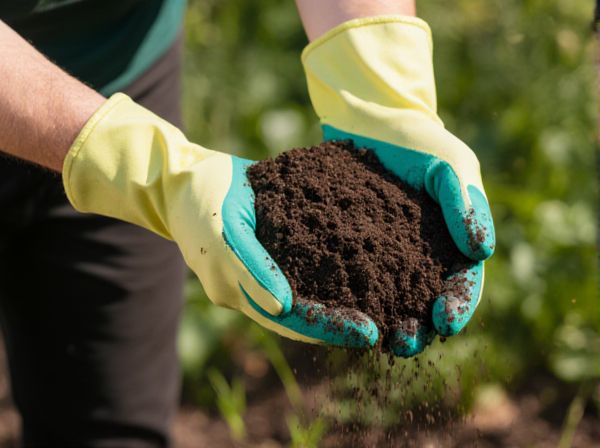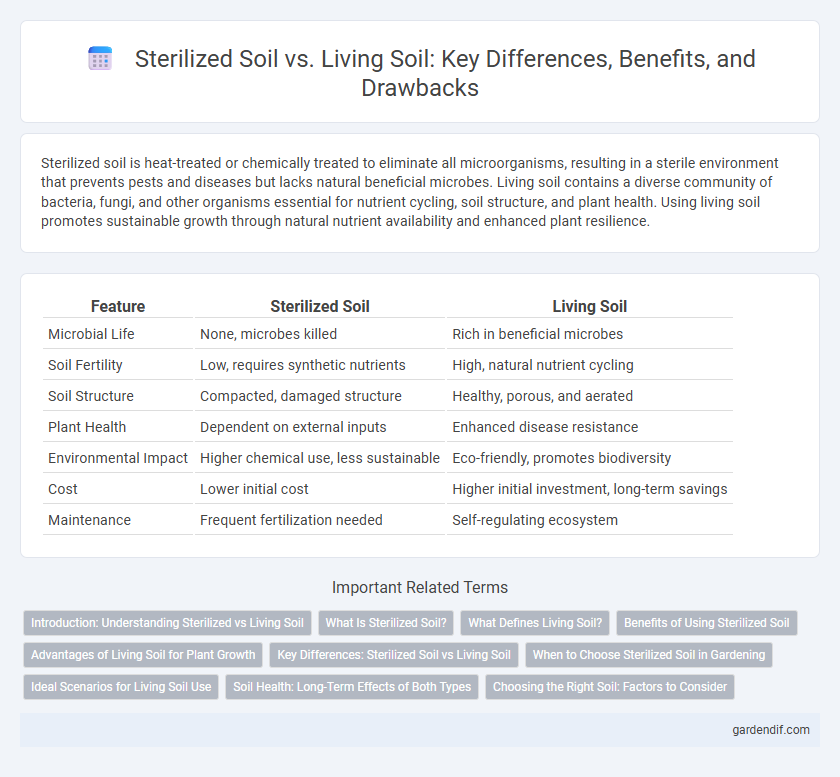
Sterilized Soil vs Living Soil Illustration
Sterilized soil is heat-treated or chemically treated to eliminate all microorganisms, resulting in a sterile environment that prevents pests and diseases but lacks natural beneficial microbes. Living soil contains a diverse community of bacteria, fungi, and other organisms essential for nutrient cycling, soil structure, and plant health. Using living soil promotes sustainable growth through natural nutrient availability and enhanced plant resilience.
Table of Comparison
| Feature | Sterilized Soil | Living Soil |
|---|---|---|
| Microbial Life | None, microbes killed | Rich in beneficial microbes |
| Soil Fertility | Low, requires synthetic nutrients | High, natural nutrient cycling |
| Soil Structure | Compacted, damaged structure | Healthy, porous, and aerated |
| Plant Health | Dependent on external inputs | Enhanced disease resistance |
| Environmental Impact | Higher chemical use, less sustainable | Eco-friendly, promotes biodiversity |
| Cost | Lower initial cost | Higher initial investment, long-term savings |
| Maintenance | Frequent fertilization needed | Self-regulating ecosystem |
Introduction: Understanding Sterilized vs Living Soil
Sterilized soil is treated to eliminate all microorganisms, creating an inert medium free from bacteria, fungi, and pests, which often leads to a lack of natural nutrient cycling and biological activity. Living soil contains diverse microbial life, organic matter, and beneficial organisms that enhance nutrient availability, soil structure, and plant health through natural processes. Understanding the differences between sterilized and living soil is crucial for optimizing soil fertility, plant growth, and sustainable agricultural practices.
What Is Sterilized Soil?
Sterilized soil refers to soil that has been treated through methods such as heat, chemicals, or radiation to eliminate all microorganisms, pathogens, and weed seeds. This process creates a sterile growing environment free from bacteria, fungi, and pests, which can prevent disease but also removes beneficial microbes essential for nutrient cycling. Sterilized soil is commonly used in nurseries and controlled agricultural settings where clean, pathogen-free media is required for seed starting or specialized plant propagation.
What Defines Living Soil?
Living soil is defined by its dynamic ecosystem composed of diverse microorganisms, organic matter, fungi, bacteria, and earthworms that enhance nutrient cycling and soil structure. Unlike sterilized soil, living soil supports natural biological processes crucial for plant health, water retention, and disease suppression. Key indicators include high microbial activity, organic carbon content, and a balanced soil food web maintaining fertility and resilience.
Benefits of Using Sterilized Soil
Sterilized soil eliminates harmful pathogens, pests, and weed seeds, creating a controlled environment that enhances seed germination and plant growth. It provides a clean medium free from microbial competition, which is beneficial for starting delicate seedlings and preventing disease outbreaks. The consistent nutrient availability in sterilized soil supports uniform plant development and reduces the need for chemical interventions.
Advantages of Living Soil for Plant Growth
Living soil enhances plant growth by fostering a diverse microbial ecosystem that improves nutrient availability and promotes robust root development. Beneficial microorganisms in living soil aid in nutrient cycling, disease suppression, and soil structure improvement, leading to healthier and more resilient plants. In contrast to sterilized soil, living soil maintains biological activity that supports sustained fertility and long-term productivity.
Key Differences: Sterilized Soil vs Living Soil
Sterilized soil is free of microorganisms, pests, and pathogens due to heat or chemical treatment, resulting in a nutrient-poor and biologically inactive medium that requires synthetic fertilizers for plant growth. Living soil contains a diverse ecosystem of beneficial microbes, fungi, and organic matter that naturally support nutrient cycling, improve soil structure, and enhance plant health. The key difference lies in biological activity and nutrient availability, where living soil fosters sustainable plant growth, while sterilized soil depends heavily on external inputs.
When to Choose Sterilized Soil in Gardening
Sterilized soil is ideal for starting seedlings, growing certain disease-sensitive plants, or when reusing soil that may contain harmful pathogens, pests, or weed seeds. It provides a clean, controlled environment that minimizes the risk of infection or competition, ensuring healthy root development and better plant establishment. Use sterilized soil in controlled environments like greenhouses or when aiming to prevent soil-borne diseases in vulnerable crops.
Ideal Scenarios for Living Soil Use
Living soil excels in organic gardening and sustainable agriculture due to its rich microbial diversity, which enhances nutrient cycling and plant health. It is ideal for crops requiring natural pest resistance and nutrient availability without synthetic inputs, promoting long-term soil fertility. Living soil is preferred in permaculture systems and regenerative farming where maintaining ecological balance and improving soil structure are priorities.
Soil Health: Long-Term Effects of Both Types
Sterilized soil eliminates harmful pathogens but also destroys beneficial microorganisms essential for nutrient cycling and soil structure, leading to reduced soil fertility over time. Living soil contains a diverse microbial ecosystem that enhances nutrient availability, improves water retention, and supports plant resilience, promoting sustainable soil health. Long-term use of living soil fosters a balanced ecosystem that sustains soil productivity, whereas repeated sterilization can degrade soil quality and increase dependency on chemical inputs.
Choosing the Right Soil: Factors to Consider
Choosing the right soil involves evaluating factors such as nutrient content, microbial activity, and pest resistance. Sterilized soil offers a pathogen-free environment but lacks beneficial microbes crucial for plant health, while living soil contains diverse microorganisms that enhance nutrient cycling and soil structure. Adapt soil choice to the specific plant species, growth phase, and environmental conditions to optimize growth and yield.
Sterilized Soil vs Living Soil Infographic

 gardendif.com
gardendif.com